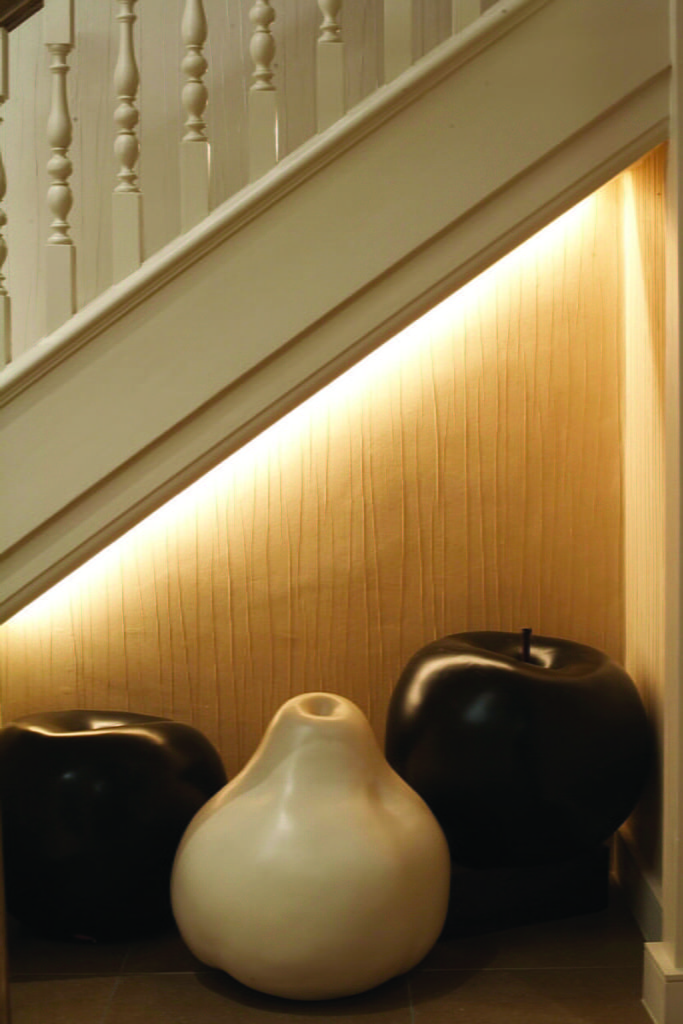The staircase is more than just a path connecting various floors in our homes or businesses. It’s a space where design and functionality converge. Notably, the area under the stairs must be more utilized.
You can transform this space into something practical and aesthetically appealing by introducing lighting. Below, we explore some innovative under-stairs lighting ideas that can inspire homeowners and designers alike.
Creating an Ambient Space with Soft Lighting

Transforming the under-stairs area into a welcoming space involves carefully balancing light and shadow. You can create a warm ambiance using soft lighting, such as dimmable LED lights or wall-mounted lanterns.
This subtle glow emphasizes architectural details and complements existing décor, adding a sophisticated touch. Adding a dimmer lets you control the intensity, making it perfect for a gentle illumination that doesn’t overpower the space. This approach invites people to utilize the area, transforming it into a comforting retreat within the home.
Accent Lighting for Display Areas

Accent lighting becomes essential if the under-stairs space houses art, sculptures, or other prized possessions. This technique focuses light on specific objects, drawing attention and enhancing their appearance.
Spotlights, track, or picture lights can be carefully positioned to create a gallery-like experience. By directing the viewer’s eye, these lighting features can elevate a simple display into a professional showcase, adding depth and dimension to the entire area.
Shelving with Integrated Lighting

This multifunctional approach combines storage with illumination. Custom-built shelves with integrated LED lights provide a practical solution for displaying books, wine, or decorative items.
These lit shelves make it easier to find objects and add a modern aesthetic. The contrast between the shadows and the illuminated shelves creates visual intrigue, turning ordinary shelving into a striking design feature.
Sensor-activated Lights for Convenience

Sensor-activated lights provide an intelligent solution for those using the under-stairs area for practical purposes. These lights turn on upon detecting movement, ensuring that the space is always well-lit when in use.
Besides convenience, this option is energy-efficient, as the lights turn off automatically when unnecessary. Ideal for pantries, coat closets, or other storage areas, this approach marries modern technology with everyday practicality.
Stair Tread Lighting for Safety and Style

Adding lights to the stair treads or alongside the stairs can be an innovative way to blend safety with style. Low-level LED lights provide a path, reducing the risk of tripping during nighttime. This lighting can be functional and visually appealing, creating a futuristic glow that complements modern interior design.
Using Colored Lights for a Dramatic Effect

Colored lighting introduces a playful or dramatic element to the under-stairs area. By employing colored LED bulbs or filters, you can create a striking effect that reflects your personality or desired mood.
Whether soothing blues for a relaxed vibe or fiery reds for a vibrant touch, colored lighting can transform the space into a unique, eye-catching feature within your home.
Chandeliers and Statement Fixtures

A chandelier or a prominent, artistic light fixture can add grandeur to spaces with enough height. These statement pieces become the focal point, drawing eyes upward and enhancing the architectural beauty of the staircase.
From classic crystal chandeliers to contemporary geometric designs, the fixture choice can be tailored to the home’s overall style, turning the under-stairs area into a luxurious space.
Creating a Cozy Reading Nook

Transforming the under-stairs space into a reading nook requires thoughtful lighting. Soft, adjustable lighting such as a well-placed floor lamp or wall sconces provides the perfect illumination level for reading.
Coupled with a comfortable chair, a small bookshelf, and perhaps a soft rug, the lighting helps create a secluded haven to escape with a good book. The key is selecting lighting that is not too harsh and maintaining a cozy and inviting atmosphere.
FAQs
LED lights, including strip and recessed, are popular due to their energy efficiency and versatility. Depending on the design, spotlights, chandeliers, or sensor-activated lights might also be suitable.
The cost can vary depending on the complexity of the design and the types of lights used. Simple LED strip lighting can be relatively affordable, while custom-designed fixtures or chandeliers can be more expensive. Consulting with a lighting designer or electrician can provide a clear cost estimate.
Some lighting solutions, such as LED strips or plug-in lamps, can be installed by a DIY enthusiast with essential tools. However, hiring a professional for more complex or wired solutions is advisable to ensure safety and compliance with local regulations.
LED lights, dimmers, or motion sensors can significantly reduce energy consumption. These options allow for adjustable brightness and ensure the lights are only on when needed.
Most staircases can accommodate some form of under-stairs lighting. The design and type of lighting would need to be tailored to the specific space, considering factors like size, shape, and the staircase’s materials.
Will Lighting in the Under Stairs Area, Affect the Overall Ambience of My Room?
Absolutely! Properly designed under-stairs lighting can enhance the overall aesthetic of a room, create focal points, or add warmth. The type of lighting and its intensity can be adjusted to complement the existing décor.
Tips About Installing Under Stairs Lighting
When installing under-stairs lighting, it’s essential to consider the purpose of the lighting (ambient, accent, or functional) and choose the appropriate fixtures. Safety is paramount, so always turn off the power and consult an electrician if needed. Measure the space, plan the layout, and select energy-efficient options if possible.
Use proper tools and follow the manufacturer’s instructions for installation. Consider adding control features like dimmers or sensors for added convenience and customization. After installation, ensure that wires are neatly concealed, and add any necessary finishing touches to blend the lighting with the overall design.

